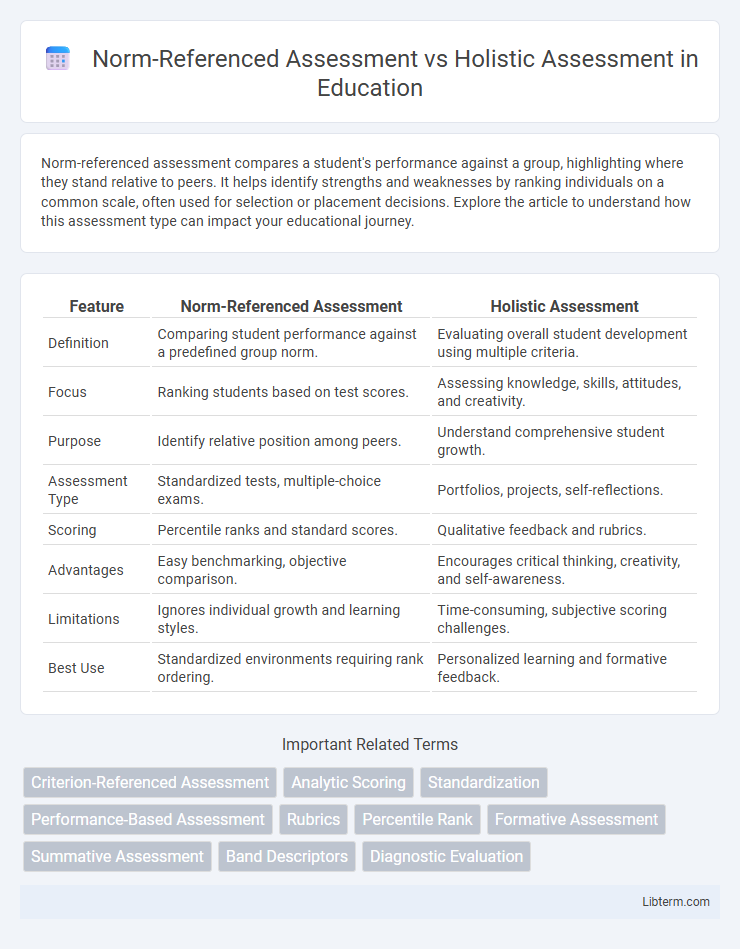Norm-referenced assessment compares a student's performance against a group, highlighting where they stand relative to peers. It helps identify strengths and weaknesses by ranking individuals on a common scale, often used for selection or placement decisions. Explore the article to understand how this assessment type can impact your educational journey.
Table of Comparison
| Feature | Norm-Referenced Assessment | Holistic Assessment |
|---|---|---|
| Definition | Comparing student performance against a predefined group norm. | Evaluating overall student development using multiple criteria. |
| Focus | Ranking students based on test scores. | Assessing knowledge, skills, attitudes, and creativity. |
| Purpose | Identify relative position among peers. | Understand comprehensive student growth. |
| Assessment Type | Standardized tests, multiple-choice exams. | Portfolios, projects, self-reflections. |
| Scoring | Percentile ranks and standard scores. | Qualitative feedback and rubrics. |
| Advantages | Easy benchmarking, objective comparison. | Encourages critical thinking, creativity, and self-awareness. |
| Limitations | Ignores individual growth and learning styles. | Time-consuming, subjective scoring challenges. |
| Best Use | Standardized environments requiring rank ordering. | Personalized learning and formative feedback. |
Introduction to Assessment Types
Norm-referenced assessment compares a student's performance against a predefined group, emphasizing ranking and relative achievement. Holistic assessment evaluates a student's overall abilities and understanding by considering multiple dimensions of learning, including creativity and critical thinking. These assessment types provide distinct insights into student progress and guide tailored instructional strategies effectively.
Defining Norm-Referenced Assessment
Norm-referenced assessment evaluates a student's performance by comparing it to a predefined group, typically using standardized tests to rank individuals based on percentile scores or grade equivalents. This type of assessment emphasizes relative standing rather than mastery of specific content, providing insights into how students perform in relation to their peers. It is widely used in educational settings to identify achievement gaps and inform placement decisions.
Understanding Holistic Assessment
Holistic assessment evaluates a student's overall learning by considering multiple dimensions such as critical thinking, creativity, and personal growth rather than just comparing scores against a norm group. It emphasizes authentic tasks and qualitative feedback, providing a comprehensive picture of individual strengths and development. This approach supports personalized learning goals and encourages deeper understanding beyond standardized test results.
Key Differences Between Norm-Referenced and Holistic Assessment
Norm-referenced assessment compares a student's performance against a predefined population, producing scores such as percentiles or standard scores that rank individuals. Holistic assessment evaluates overall learning and skills by considering multiple aspects of a student's work, emphasizing qualitative judgment and comprehensive understanding. Key differences include norm-referenced tests focusing on relative ranking and quantitative scores, while holistic assessments prioritize individualized feedback and integrated evaluation of knowledge, skills, and attitudes.
Advantages of Norm-Referenced Assessment
Norm-referenced assessments provide a clear comparison by ranking students against a defined population, enabling educators to identify relative performance levels effectively. These assessments facilitate large-scale data analysis and standardized reporting, making them valuable for benchmarking and policy decisions. Their structured format allows for objective scoring and efficiency in measuring specific skills across diverse groups.
Benefits of Holistic Assessment
Holistic assessment provides a comprehensive evaluation of a learner's abilities by considering cognitive, emotional, and social factors, which promotes a deeper understanding of individual progress beyond mere test scores. It supports personalized learning and encourages self-reflection, fostering intrinsic motivation and long-term academic development. This approach also adapts to diverse learning styles, making education more inclusive and equitable.
Limitations and Criticisms of Norm-Referenced Assessment
Norm-referenced assessment often faces criticism for emphasizing competitive ranking over individual progress, potentially neglecting diverse learning needs and contextual factors. Its reliance on fixed percentile ranks can perpetuate achievement gaps and discourage collaborative learning environments. This approach limits growth-focused feedback, making it less effective for guiding personalized instruction and fostering intrinsic motivation.
Challenges and Drawbacks of Holistic Assessment
Holistic assessment faces challenges in maintaining consistent and objective evaluation criteria due to its subjective nature, which can lead to variability in scoring across different assessors. The lack of standardized benchmarks makes it difficult to compare student performance reliably, often resulting in perceptions of bias or unfairness. Additionally, holistic assessments require significant time and training for evaluators to develop accurate judgment skills, increasing administrative burdens.
Choosing the Right Assessment Approach
Choosing the right assessment approach depends on the educational goals and context; norm-referenced assessments effectively measure student performance against a peer group, providing standardized comparisons ideal for ranking or selection purposes. Holistic assessments prioritize evaluating overall student understanding, creativity, and critical thinking through qualitative data, making them suitable for fostering deep learning and personalized feedback. Educators must consider whether the emphasis is on comparative ranking or comprehensive skill evaluation to select the most appropriate assessment method.
Conclusion: Balancing Norm-Referenced and Holistic Methods
Balancing norm-referenced and holistic assessment methods enhances educational evaluation by integrating standardized comparison with comprehensive understanding of student abilities. Norm-referenced assessments provide quantifiable data for ranking, while holistic assessments capture diverse cognitive, emotional, and social skills. Combining these approaches supports fairer, more accurate representations of learner performance and growth.
Norm-Referenced Assessment Infographic

 libterm.com
libterm.com